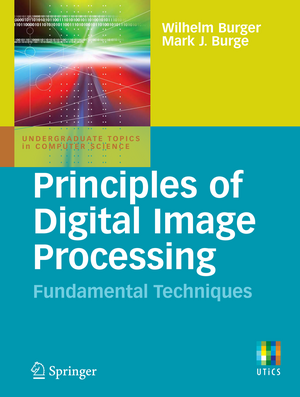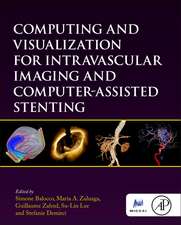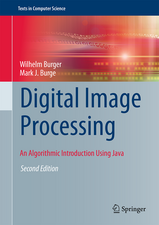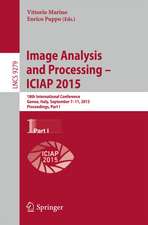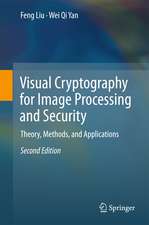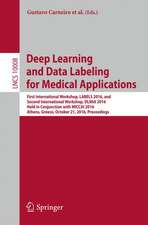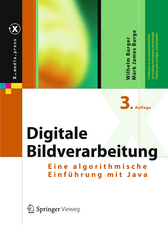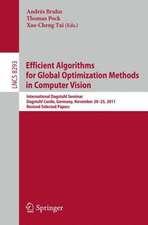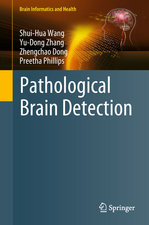Principles of Digital Image Processing: Fundamental Techniques: Undergraduate Topics in Computer Science
Autor Wilhelm Burger, Mark J. Burgeen Limba Engleză Paperback – 23 apr 2009
| Toate formatele și edițiile | Preț | Express |
|---|---|---|
| Paperback (3) | 227.15 lei 6-8 săpt. | |
| SPRINGER LONDON – 23 apr 2009 | 227.15 lei 6-8 săpt. | |
| SPRINGER LONDON – 2 apr 2009 | 312.68 lei 6-8 săpt. | |
| SPRINGER LONDON – 22 mai 2013 | 366.18 lei 38-44 zile |
Din seria Undergraduate Topics in Computer Science
- 20%
 Preț: 280.92 lei
Preț: 280.92 lei - 20%
 Preț: 233.75 lei
Preț: 233.75 lei - 20%
 Preț: 350.89 lei
Preț: 350.89 lei - 20%
 Preț: 245.43 lei
Preț: 245.43 lei - 20%
 Preț: 187.22 lei
Preț: 187.22 lei - 20%
 Preț: 316.24 lei
Preț: 316.24 lei - 20%
 Preț: 287.22 lei
Preț: 287.22 lei - 20%
 Preț: 306.71 lei
Preț: 306.71 lei - 20%
 Preț: 258.78 lei
Preț: 258.78 lei - 20%
 Preț: 226.64 lei
Preț: 226.64 lei - 20%
 Preț: 179.87 lei
Preț: 179.87 lei - 20%
 Preț: 395.04 lei
Preț: 395.04 lei - 20%
 Preț: 272.43 lei
Preț: 272.43 lei - 20%
 Preț: 305.01 lei
Preț: 305.01 lei - 20%
 Preț: 306.58 lei
Preț: 306.58 lei - 20%
 Preț: 192.73 lei
Preț: 192.73 lei -
 Preț: 334.88 lei
Preț: 334.88 lei - 20%
 Preț: 341.95 lei
Preț: 341.95 lei - 20%
 Preț: 342.45 lei
Preț: 342.45 lei - 20%
 Preț: 305.61 lei
Preț: 305.61 lei - 20%
 Preț: 225.02 lei
Preț: 225.02 lei - 20%
 Preț: 276.82 lei
Preț: 276.82 lei - 20%
 Preț: 375.53 lei
Preț: 375.53 lei - 20%
 Preț: 254.37 lei
Preț: 254.37 lei - 20%
 Preț: 237.35 lei
Preț: 237.35 lei - 20%
 Preț: 374.37 lei
Preț: 374.37 lei - 20%
 Preț: 307.16 lei
Preț: 307.16 lei - 20%
 Preț: 374.20 lei
Preț: 374.20 lei - 20%
 Preț: 246.39 lei
Preț: 246.39 lei - 20%
 Preț: 237.62 lei
Preț: 237.62 lei - 20%
 Preț: 463.43 lei
Preț: 463.43 lei - 20%
 Preț: 297.28 lei
Preț: 297.28 lei - 20%
 Preț: 304.44 lei
Preț: 304.44 lei - 20%
 Preț: 579.37 lei
Preț: 579.37 lei - 20%
 Preț: 298.18 lei
Preț: 298.18 lei - 20%
 Preț: 302.80 lei
Preț: 302.80 lei - 20%
 Preț: 300.89 lei
Preț: 300.89 lei - 20%
 Preț: 191.35 lei
Preț: 191.35 lei - 20%
 Preț: 243.35 lei
Preț: 243.35 lei - 20%
 Preț: 297.66 lei
Preț: 297.66 lei - 20%
 Preț: 278.10 lei
Preț: 278.10 lei - 20%
 Preț: 389.96 lei
Preț: 389.96 lei - 20%
 Preț: 184.28 lei
Preț: 184.28 lei - 20%
 Preț: 304.21 lei
Preț: 304.21 lei - 20%
 Preț: 281.40 lei
Preț: 281.40 lei - 20%
 Preț: 754.32 lei
Preț: 754.32 lei
Preț: 227.15 lei
Preț vechi: 283.93 lei
-20% Nou
Puncte Express: 341
Preț estimativ în valută:
43.48€ • 44.80$ • 36.70£
43.48€ • 44.80$ • 36.70£
Carte tipărită la comandă
Livrare economică 04-18 martie
Preluare comenzi: 021 569.72.76
Specificații
ISBN-13: 9781848001909
ISBN-10: 1848001908
Pagini: 260
Ilustrații: XIV, 261 p. With online files/update.
Dimensiuni: 178 x 254 x 15 mm
Greutate: 0.54 kg
Ediția:2009
Editura: SPRINGER LONDON
Colecția Springer
Seria Undergraduate Topics in Computer Science
Locul publicării:London, United Kingdom
ISBN-10: 1848001908
Pagini: 260
Ilustrații: XIV, 261 p. With online files/update.
Dimensiuni: 178 x 254 x 15 mm
Greutate: 0.54 kg
Ediția:2009
Editura: SPRINGER LONDON
Colecția Springer
Seria Undergraduate Topics in Computer Science
Locul publicării:London, United Kingdom
Public țintă
Lower undergraduateCuprins
Digital Images.- ImageJ.- Histograms.- Point Operations.- Filters.- Edges and Contours.- Morphological Filters.- Color Images.
Recenzii
From the reviews:
"This slim volume is the first of a three-volume set. … the book’s overall coverage is sound--well written, with plenty of illustrative examples and elegant diagrams. … this book is a fine introduction to image processing, and some topics--color, in particular--are very well done indeed. … In summary, this is mostly a fine text. … with the addition of more exercises, this would be an excellent introduction to the field." (Alasdair McAndrew, ACM Computing Reviews, August, 2009)
"This slim volume is the first of a three-volume set. … the book’s overall coverage is sound--well written, with plenty of illustrative examples and elegant diagrams. … this book is a fine introduction to image processing, and some topics--color, in particular--are very well done indeed. … In summary, this is mostly a fine text. … with the addition of more exercises, this would be an excellent introduction to the field." (Alasdair McAndrew, ACM Computing Reviews, August, 2009)
Textul de pe ultima copertă
This easy-to-follow textbook provides a modern, algorithmic introduction to digital image processing, designed to be used both by learners desiring a firm foundation on which to build, and practitioners in search of critical analysis and concrete implementations of the most important techniques. The text compiles the key elements of digital image processing, starting from the basic concepts and elementary properties of digital images through simple statistics and point operations, fundamental filtering techniques, localization of edges and contours, and basic operations on color images. Mastering these most commonly used techniques will enable the reader to start being productive straight away.
Features and topics:
Wilhelm Burger, Ph.D., is the director of the Digital Media degree programs at the UpperAustria University of Applied Sciences at Hagenberg.
Mark J. Burge, Ph.D., is a senior principal in the Center for National Security and Intelligence at Noblis in Washington, D.C.
Features and topics:
- Practical examples and carefully constructed chapter-ending exercises drawn from the authors' years of experience teaching this material
- Real implementations, concise mathematical notation, and precise algorithmic descriptions designed for programmers and practitioners
- Easily adaptable Java code and completely worked-out examples for easy inclusion in existing (and rapid prototyping of new) applications
- Uses ImageJ, the image processing system developed, maintained, and freely distributed by the U.S. National Institutes of Health (NIH)
- Provides a supplementary website with the complete Java source code, test images, and corrections – www.imagingbook.com
- Additional presentation tools for instructors including a complete set of figures, tables, and mathematical elements
Wilhelm Burger, Ph.D., is the director of the Digital Media degree programs at the UpperAustria University of Applied Sciences at Hagenberg.
Mark J. Burge, Ph.D., is a senior principal in the Center for National Security and Intelligence at Noblis in Washington, D.C.
Caracteristici
This reader-friendly textbook concentrates on practical applications and working implementations whilst also presenting the important formal details and mathematics necessary for a deeper understanding of the algorithms Comprehensive yet concise, this text contains many learning aids throughout such as end of chapter exercises, detailed illustrations, comprehensive introductory chapter and helpful appendices Includes supplementary material: sn.pub/extras
